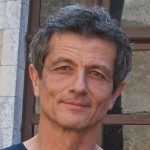Link to Pubmed [PMID] – 2101632
New Biol. 1990 Nov;2(11):937-45
In higher eukaryotes, gene activation is accompanied by an increased sensitivity to DNaseI over a domain that extends beyond the limits of the gene itself, or of the gene cluster to which it belongs. This increased sensitivity probably reflects both the partial decondensation of chromatin and an increased communication with the outside of the nucleus. In addition, gene activation usually causes a coreplication domain that extends much beyond the decondensation domain to switch to an early replication time in S phase. This switch is produced, at least in some cases, by an early firing of origins of replication situated in flanking condensed chromatin. Some of the recently identified DNA domains that tether chromosomal loops to the nuclear matrix do represent the borders of decondensation domains. They may also constitute pausing sites for replication forks. The different replication times of successive 200- to 400-kb regions along the genome may have been the basis for the observed long-term differentiation of very large genomes in domains of different overall sequence composition (G:C content and distribution of short repeated motifs). Chromosomal bands represent a low resolution picture of this pattern. Just like gene methylation, differential replication timing and the consequent compositional differentiation of the genome have probably contributed to making the management of very large genomes workable.
